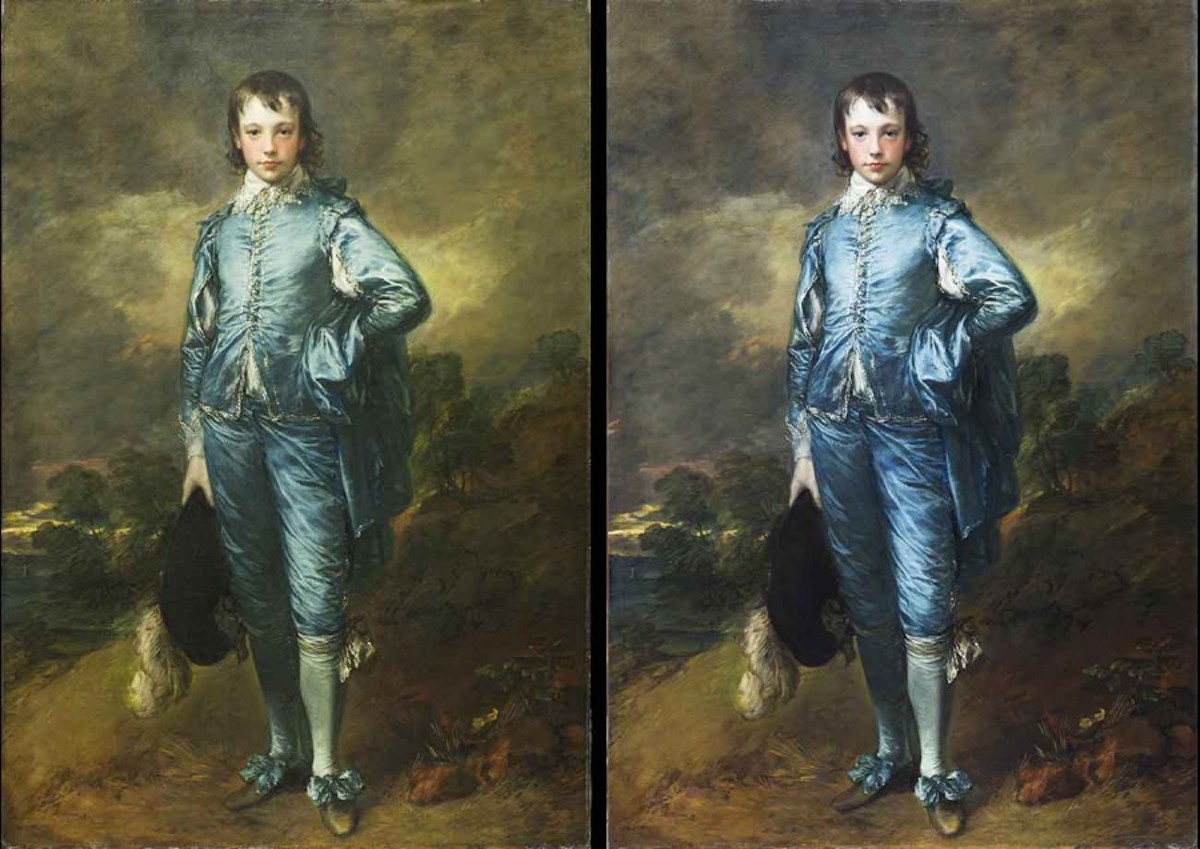
MEDIA RELEASE:
One of the most famous works at The Huntington Library, Art Museum, and Botanical Gardens, The Blue Boy (ca. 1770) by Thomas Gainsborough (1727–1788), has been reinstalled in the Thornton Portrait Gallery and will be on view for visitors when the Huntington Art Gallery is allowed to reopen. The painting was originally scheduled for installation in March 2020, but was delayed due to mandatory COVID-related museum closures. Now, when visitors are allowed to return, they will see a masterpiece resplendent after an extensive 18-month initiative to analyze, conserve, and restore the work. Minute shades of color, fine brushstroke textures, and nuanced details of the famous figure of a young man in a blue satin costume, as well as the landscape in which he stands, are once again legible and closer to what Gainsborough intended.
“Gainsborough’s Blue Boy has inspired generations of artists and scholars, and absolutely captivated the public imagination since it was first displayed publicly in 1770,” said Huntington President Karen R. Lawrence. “As stewards of this iconic masterpiece, we are thrilled with the results of this landmark conservation project that has restored the painting’s original brilliance and ensured its wellbeing for years to come. We can now see the vivid palette and the bold composition much more clearly than in decades past, and we cannot wait to share the painting with our visitors again, once it is safe to do so.”
With much of the conservation process carried out in public view during The Huntington’s “Project Blue Boy” exhibition (Sept. 22, 2018–Sept. 30, 2019), the major undertaking involved high-tech data gathering and analysis as well as more than 500 hours of expert conservation work to remove old overpaint and varnish, repair and reattach the lining and other structural materials, and inpaint areas of loss as a result of flaking and abrasion.

Christina O’Connell, The Huntington’s Mary Ann and John Sturgeon Senior Paintings Conservator and leader of the project, removed several uneven layers of dirt and discolored varnish with small cotton swabs to reveal Gainsborough’s original brilliant blues and other pigments. Then, with tiny brushes, she reconnected the artist’s brushstrokes across the voids of past damage as part of the inpainting process. As O’Connell worked on the painting, she became intimately aware of Gainsborough’s every brushstroke. “It’s been an incredibly deep professional experience,” she said. “Conservation work is very much a process of discovery. I’ve not only had a view of the painting at the microscopic level, but I was also able to observe each stroke as the true colors of Gainsborough’s palette were revealed from underneath many layers of dirt and discolored varnish.”
During the process, O’Connell discovered that although Gainsborough painted The Blue Boy on a recycled canvas (as revealed in earlier X-rays), he made considerable use of a complex network of paint layers and pigments to create a painting that truly showed off his skills.
“We have to remember that this painting wasn’t commissioned, but rather was produced by Gainsborough for the express purpose of showing off his prowess at the Royal Academy exhibition of 1770—where it would be seen next to the work of his rivals,” said Melinda McCurdy, The Huntington’s associate curator for British art and co-curator of “Project Blue Boy.” “Gainsborough intended it to grab attention, and conservation work has revealed the incredible technical skill he brought to this showpiece.”
Other discoveries made over the course of the project, which was supported by a grant from Bank of America as a part of its global Art Conservation Project, include one relating to the painting’s lining. After observation and analysis, conservators determined that the lining adhesive for The Blue Boy correlated to a historic recipe for a paste made of rye flour and ale. O’Connell enlisted the help of a food historian to recreate the paste with modern ingredients to construct a mock-up in order to observe how the materials for the lining behaved.
Credit
Conservation was funded by a grant from the Bank of America Art Conservation Project. Additional generous support for this project was provided by the Getty Foundation, Kim and Ginger Caldwell, Friends of Heritage Preservation, and Haag-Streit USA.















.png)






